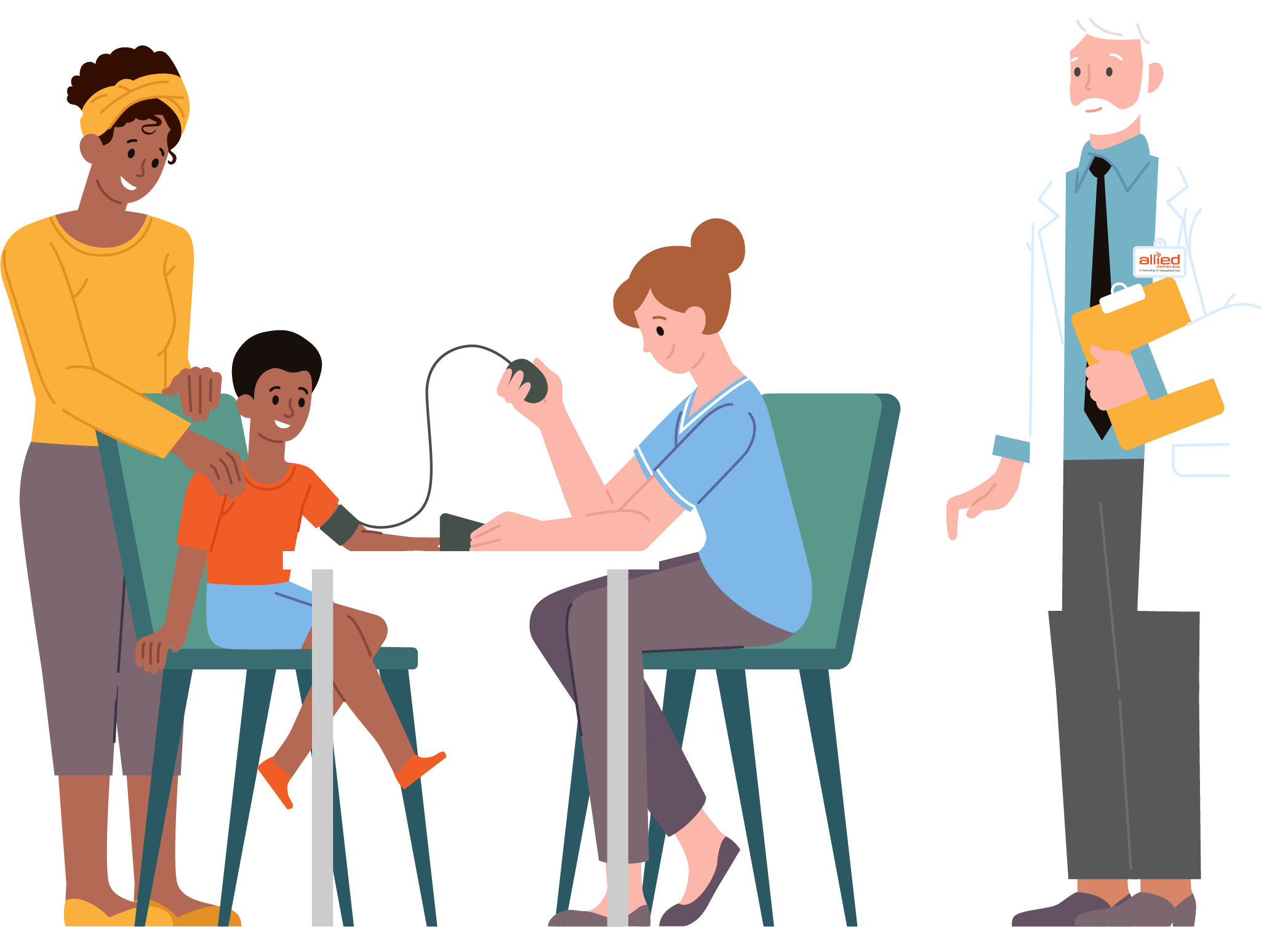Welcome to Allied Pediatrics & Family Medicine of Bellmore-Merrick
Here at Allied Pediatrics & Family Medicine of Bellmore-Merrick, we pride ourselves on creating a friendly environment for both you and your family! Our trusted team of clinicians are here to provide Bellmore, NY, Merrick, NY, and Long Island with the comprehensive and trusted care that Allied Physicians Group is known for. Our main goal is to provide unparalleled healthcare and compassionate service to all who enter our doors.
Allied Pediatrics & Family Medicine provides care from birth through the golden years. We deliver a full range of both pediatric and adult care services for whatever your needs may be. Our team is committed to providing quality care in a comfortable, safe environment where you and your family can feel at ease.
Schedule Appointment
Directions to Our Practice
Link to location address2154 Newbridge Rd, Bellmore, New York 11710
Phone: Link to location phone number516-409-8800
Fax: Link to location fax number516-409-4921
Link to Schedule a tour pageSchedule an Office Tour!Practice Hours
Monday: 8:00AM – 7:00PM
Tuesday: 8:00AM – 7:00PM
Wednesday: 8:00AM – 7:00PM
Thursday: 9:00AM – 7:00PM
Friday: 9:00AM – 7:00PM
Saturday: 9:00AM – 2:00PM
Sunday: Closed
**Telehealth available daily until 10:30PM
Our Services
Infancy, childhood, adolescence, and young adulthood are delicate periods for a child. Well visits are an essential part to live a healthy life. It is important to keep up-to-date with your child’s visits and immunizations.
Routine Well Visits
Our pediatricians monitor your child’s growth to ensure they meet all milestones and benchmarks. We provide easy-to-follow care schedules for your child based on age, medical history, and other essential factors.
Well visits include:
- General screenings
- Immunizations
- Lab work
- Physicals
Sick Visits
When your child experiences a common illness, our pediatricians are available to treat your sick child as soon as possible in a compassionate, friendly environment. Patients can also access specialty clinicians should an illness require advanced diagnostic attention or care.
Immunizations
Immunizations and vaccinations are important to shield your little one against preventable diseases, such as whooping cough (pertussis) and measles, which can be extremely dangerous to your children. It is important to stay on top of your child’s immunization schedule by attending all your child’s well visits.
Minor Injury Care
Much like sickness, injuries tend to occur suddenly and without warning. If your child suffers a minor injury and requires medical attention, our pediatricians can apply the treatments needed for proper healing.
View ServiceWe offer adult medicine services such as:
- Well Visits
- Sick Visits
- Chronic Conditions
- Asthma Treatment
- Behavioral Health
- Womens Health
- Diabetes Management
- Health Screenings
- Heart Health
- Minor Injury Treatment
- Medical Weight Management
No matter where you are, you can rely on us for dependable pediatric care using our telehealth services. Our physicians consult with you via video conferencing to evaluate conditions, manage symptoms, and advise you on proper care—no office visit required!
How Does Pediatric Telehealth Work?
Patients can connect with their doctor virtually through the patient portal. Similar to a FaceTime, Skype, or Zoom call, simply log into your patient portal to get started!
What Can My Pediatrician Evaluate:
- Acne
- Allergies
- Asthma control education
- Behavioral health
- Breastfeeding support
- Colds and other minor illnesses
- Constipation, diarrhea, or vomiting
- COVID-19 (coronavirus symptoms)
- Fever
- Minor trauma screening (cuts, abrasions, animal bites)
- Nutrition support
- Pink eye
- Rash
And much more!
The Pediatric Telehealth Process
Step One – Open your patient portal account
Step Two – Tap “find appointments” and select the type of physician you would like to see along with the reason for the visit
Step Three – Tap “show appointments” and then click on the “online” tab to see available Athena Telehealth appointments
Please tap on the calendar icon to select a date
Step Four – Select the date and time of your appointment
For online appointments, you will see a physician icon with a smaller green camera icon next to it indicating that these are available Athena Telehealth appointments.
Step Five – Review the required patient information fields before tapping “schedule appointment” to book your appointment
You are able to then add your appointment to either your Outlook, Google, or iOS calendar. Please note, if availability is not seen for your primary care physician, please call the office to schedule your telehealth visit.
Preparing For Your Telehealth Visit:
Once your pediatric telehealth appointment is created, you will receive two links. The first link will be a pre-registration and check-in link from Phreesia. The second link will be from athenaOne to either the phone number or e-mail on the account. This will be the link you will utilize for your telehealth appointment. The athenaOne link will bring you to the login for the virtual waiting room before your telehealth appointment.
Once you’re in the virtual waiting room, your physician will be notified you are there and they will join you for the consultation.
Telehealth Hours
Daytime Visits: Monday – Friday 8:00 am to 6:30 pm
After-Hour Visits: Seven Days a Week 6:30 pm to 10:30 pm
To schedule an appointment during daytime hours, please call the office. To schedule an appointment after-hours, please call 833-269-2444.
After-Hours Telehealth Visits
After-hours telehealth visits are available seven nights a week with an Allied pediatrician from 6:30 pm to 10:30 pm. For technical issues or concerns, you can speak with a telehealth coordinator at 833-269-2444 any time after 6:30 pm.
View ServiceEar piercing can be separated into two categories – infancy and “when they are old enough to ask for it.”
Infancy – Ear piercing during infancy is best done between 3 and 10 months. Before 3 months they are too young and after 10 months they are more active making the actual piercing more difficult.
Older children – Ear piercing after 10 months of age may be slightly more complex. Not only does the child have to ask for the piercing, but they have to sit still for the piercing as well. After 10 months we recommend 3-year-olds being the youngest. However, we can assess on a child-by-child basis depending on the individual.
Ear piercing is not covered by insurance.
We solely pierce ear lobes. We do not pierce the cartilage higher up on the ear as the risk of infection is too great. We do not pierce any other body parts.
We use the patented Medi-System which is only available in a physician’s office. The earring goes in and the backing goes on at the time of the piercing. The tiny “diamond” stud is surrounded by 24-karat gold and the only metal touching your child’s skin is titanium. This inert metal is the least likely to cause any kind of allergic reaction at the site of the piercing.
View ServicePediatric and Family Medicine Care Team of Bellmore, New York
The skilled pediatricians, nurses, and staff at Allied Pediatrics & Family Medicine of Bellmore-Merrick ensure your family receives the best possible care in Bellmore, New York. As members of Allied Physicians Group, Jorge Nieves, MD, Erika Schwarz-Cohen, MD, Muskan Ghotra, MD, Warren Silberstein, MD, Ryan Buckly, PA, Cyd Greco, NP, and Michelle Michitsch, PNP have access to a network of physician services to support our pediatric services, solutions, resources, and capabilities for your child’s health. Learn more about our pediatricians and our practice’s commitment to your family in Bellmore, New York.
-
Headshot of Jorge Nieves, MD

Jorge Nieves, MD
Read Bio about Jorge Nieves, MD -
Headshot of Erika Schwarz-Cohen, MD

Erika Schwarz-Cohen, MD
Read Bio about Erika Schwarz-Cohen, MD -
Headshot of Muskan Ghotra, MD

Muskan Ghotra, MD
Read Bio about Muskan Ghotra, MD -
Headshot of Ryan Buckly, PA

Ryan Buckly, PA
Read Bio about Ryan Buckly, PA -
Default image

Cyd Greco, NP
-
Headshot of Michelle Michitsch, PNP

Michelle Michitsch, PNP
Read Bio about Michelle Michitsch, PNP
Virtual Office Tour
Helpful Quick Links
About Allied Pediatrics & Family Medicine of Bellmore-Merrick in Bellmore, New York
We’re here for our patients every step of the way, preparing them with the care, tools, and resources necessary for the development of healthy children and beyond. We are happy to offer our patients the best services including,
– Well & Sick visits
– Telehealth
– Breastfeeding Support
– Newborn & New Parent Education
– Patient Webinars
– Trusted information from your physicians including blog and videos
– Community centered Facebook page where the latest medical & office news and updates are shared
– And more!

Helpful Tools for Your Child's Health
About Allied Physicians Group in New York
Founded in 2006, Allied Physicians Group is the largest physician-owned pediatric partnership in New York metropolitan area. As a physician-led organization, Allied Physicians Group is a growing partnership of more than 35 pediatric practices, asthma, allergy, immunology, pulmonary specialists, and adult medicine physicians, who are located throughout Greater New York City, Long Island, and the lower Hudson Valley region. Each year, the 150 clinicians of Allied Physicians Group see more than 180,000 patients and remain dedicated to comprehensive, quality healthcare for all patients.

Read the Latest Pediatric Articles from APG Pediatricians
Pediatrician Interview Questions: What to Ask Before Baby Arrives
As you approach the final stretch of your pregnancy, one important step in preparing for your baby's arrival is choosing…
Read More about Pediatrician Interview Questions: What to Ask Before Baby ArrivesHow Soon After Birth Should Your Baby See the Pediatrician?
After the whirlwind event of welcoming a new baby into the world, one of the first real-world adventures you embark…
Read More about How Soon After Birth Should Your Baby See the Pediatrician?What To Do When You Choose a Pediatrician: Next Steps
What To Do When You Choose a Pediatrician: Next Steps Congratulations! You've navigated the maze of how to choose a…
Read More about What To Do When You Choose a Pediatrician: Next Steps




